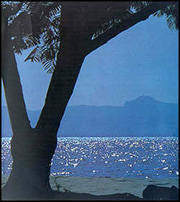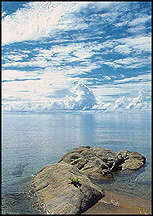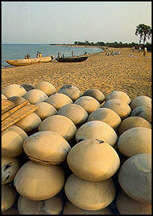 MALAWI´S LAKE OF STAR MALAWI´S LAKE OF STAR |
Tourism
Magic of Malawi
Discovering Eden
Translucent waters, shimmering sands, a profusion of exotic foliage, the velvety outline of distant hills on a far shore – Lake Malawi awakes.

As the glowing sun lights up the eastern sky, rising dramatically over the distant hills, the still waters are suffused with a golden light. This vast stretch of inland water sparkling fresh, new every, morning with vibrant birdsong, the screech of a baboon, the passage of early morning fishermen, is a jewel to be treasured, explored and reminisced over in time to come.
LAKE MALAWI stretches from the southern playground of NKOPOLA LODGE and CLUB MAKOKOLA northwards towards Tanzania, a distance of almost 570km, and boasting a coastline of striking beauty and variety. With its width in some points as much as 80km, it gives the impression of open sea, but its waters are fresh and sparkling clear. This peaceful inland waterway can, at times be transformed into a rough sea, but the protected southern bays are generally ideal for swimming and water sports.
 A LAKE IS BORN A LAKE IS BORN |
Lake Malawi was formed during times of seismic upheaval when the earth’s crust was split in a long gash stretching from the Dead Sea right down the length of Africa as far as the Zambezi River. The floor of this Great Rift contains Africa’s spectacular, long narrow lakes, with coastal plains rising into steep escarpments, such as the Nyika Plateau. The southernmost lake in the chain is Lake Malawi, the waters of which feed into the Shire River and there are carried via falls and rapids, through deep gorges and winding across plains, until the Shire spills its waters into the great Zambezi River.
 ROCKY COVES AND SUN-SPANGLED BEACHES ROCKY COVES AND SUN-SPANGLED BEACHES |
The southern part of the Lake contains spectacular scenery, with verdant hills tumbling down into deep clear water primeval rocky outcrop worn smooth by centuries of wave action, secret sand coves and unabashed stretches of endless white beaches. The water laps incessantly, though appearing mirror-like in the wide-open stretches, and rocky islands inviting exploration are scattered in the middle distance. And beyond, almost another dimension, the blue hills form a backdrop to this ‘lake of stars’ David Livingstone’s apt description of it.

Set among the rocks and rush green hills, NKOPOLA LODGE offers breathtaking views across the Lake. Sandy beaches, well-tended lawns and a variety of water sports are the main outdoor attraction, while the hill- and lakeside bedrooms, excellent cuisine, well stocked bar, beach bar and curio shop cater for all your holiday needs.
CLUB MAKOKOLA, a delightful complex of thatched cottages and a double storey wing with air conditioning, is set among tall shady trees, wide lawns and fronts the lake with a wide beach of fine sand, looking across to distant Boadzulu Island.
Northwards is Monkey Bay, ringed with hills – a tranquil haven of calm waters. The ILALA II departs from this delightful harbour on its sheduled cruises around the Lake. A few kilometres further north is CAPE MACLEAR, steeped in history, clocked by dense and luxuriant vegetation and with an unparalleled view from its tropical beach.
Here campaign facilities are provided, so stop over and absorb the aura of the past, visit the missionary graves dating back a hundred years – this was the site of the first Livingstonia Mission in 1875 – and enjoy swimming and snorkelling in the clear waters.
THE LIVINGSTONIA BEACH HOTEL, at the Salima Lakeshore has a commanding view of the Lake’s seemingly endless stretches of blue water. The hotel is set in spacious grounds with one of the finest long beaches on the Lake, and is ideal for all water sports.
Accommodation ranges from honeymoon chalets to modern bedrooms with en-suite facilities, and the hotel has an excellent menu. One of the delights in store for you is that first taste of chambo, the bream-type fish so prolific in the Lake. Freshly caught and served, it has no peers!
The lake is at its narrowest point here, and dhows and dugout canoes have plied the route to the far shore since earliest times. There are many picturesque fishing villages in this area.
Nkhotakota distils the essence of Africa. Centre of the flourishing Arab slave trade route when David Livingstone first arrived there, it is still a large settlement with busy trading stores and a mosque with splendidly carved Arab door. A large avenue of kapok trees, reputedly dating back to 1895, and the even older wild fig trees (one of which was supposed to have sheltered Livingstone) are unique features of this small town.
LIKOMA ISLAND lies north-east of Nkhotakota, closer to the eastern shore of the Lake, and is the site of St. Peter’s Cathedral, built between 1902 and 1905, a large imposing edifice of soaring columns and stained glass windows. Memorials to the early missionaries and martyrs abound, as it was the headquarters of the Universities Mission to Central Africa.
| The island is the largest in the lake, 8km long and 3km wide, and has attractive beaches and good fishing.

North from Nkhotakota, CHINTHECHE INN, is the perfect base for exploring the hinterland, or just soaking in the beauty of the surrounding, the broad sweep of white shimmering sand, scattered with quartz pebbles and delicate shells, mango trees shedding their succulent fruit, and the clear velvety water. Nearby, at Old Bandawe, a crumbling old church marks a spot where Christians have worshiped for more than a century, from the time of arrival of missionaries in 1878.
NKHATA BAY rivals Cape Maclear in the beauty of its setting, with impressive hills rising steeply and many delightful rocky coves and sandy beaches. Coffee and rubber plantations are found in this area.
The scenic coastline extends up to Karonga, the oldest settlement site so far discovered on the Lakeshore. Evidence has been revealed of early Stone Age habitation in the area. It was notorious for its slave – trading activities and resultant skirmishes, and during World War I was the scene of an encounter between British and German troops.
 THE BIG SPLASH THE BIG SPLASH |
For the water sport enthusiast, the Lake is unsurpassed. The unimpeded stretches of clear safe water are a paradise for water skiers and board sailors – this is heady exhilaration. For those who thrill to the joy of sailing, the Lake offers sheer delight – there are very few days when a breeze doesn’t stir, and often the winds on the open Lake provide a real challenge.
Due to the tremendous following this sport has attained, an annual yachting marathon is now held, with participation from near and far. The Lake turns festive with many coloured sails and busy support boats. The route follows the scenic coastline right up the far north of the Lake, and provides great entertainment for spectators in all ports of call. This marathon takes place in the middle of July.
For those who simply like messing about in boats, there are various paddle craft, canoes and pedallos for fun times.
An unforgettable experience is to take off on a days cruise(hotel will provide a packed lunch) and drop anchor off an island, there to enjoy the swimming or explore the fascinating world just below the masks and flippers. This is a world of coves alive with brightly coloured fish which defies description.
While you settle in the shade to enjoy your picnic, take in the spectacle around you – velvet monkeys chattering in the dappled shade, cormorants encrusting the rocky outcrop, wings outstretched to dry, or perhaps a fish eagle swooping past, intent on grasping a juicy morsel from the Lake.
Returning shore wards you have a breathtaking view of your hotel nestled among the rocks and trees and dwarfed by the grandiose scenery.
 A CRUISE TO REMEMBER A CRUISE TO REMEMBER |
If shipboard life appeals to you, there can be no more delightful a way of discovering Lake Malawi than on a six day cruise on ILALA II. Leaving the tropical exuberance of the harbour at Monkey Bay, the ILALA slips gently into the open Lake and the world of blue ahead of you – all shades from azure to deep purple. The distant hills are mysterious and softly blue, and one recalls the similar journey made by the first missionaries and explores as they set sail into the unknown. From the vantage point of the upper deck and first-class accommodation, one is aware of excited passengers – travellers in less exalted style – as they wave farewell to friends. The ILALA is extensively used by Malawians lakeshore residents as a novel bus service.
Accommodation consists of four double and two single cabins, meals are served in a comfortable dining salon, and a well stocked bar serves refreshments throughout the longest and laziest days of your life.
You will call at Chipoka and Nkhotakota anchoring out in deep water away from the jetty. The latter is one of the largest settlements on the Lakeshore. You will be taken across by motorboat to explore the trading stores and busy outdoor curio stores.
The ILALA then crosses Likoma Island for a few hour’s stop, then back to Nkhata Bay and Chilumba, the northernmost port of call. Here, as at all the other stops, there is a busy coming and going of passengers.
On this northern stretch of the Lake, the views of the Viphya and Livingstonia escarpments are breathtaking. This form the wall of the Great Rift Valley, and one can only be awed by forces of nature which gave rise to this phenomenon, this unforgettable grandeur.
 STRIKING CONTRASTS STRIKING CONTRASTS |
In the small Lakeshore villages watch out for age-old traditions employed by the villagers as the manufacture fishing nets. The raw material for the locally produced thread comes from a shrub growing here. These skilfully constructed nets cab be seen spread out on the sand to dry after a fishing expedition.
The dugout canoe is a unique and picturesque feature of the Lake and river life throughout this area. It is carved from a single large tree trunk – a long and a painstaking procedure. Skilful handling is required to keep these long narrow canoes from overturning while poling them through the water, in the manner of somewhat more sophisticated Italian gondola.
When fishing, boats operate in pairs, dropping a net between them and trailing behind for a short distance, then hauling in it and pouring the silvery catch into the canoes.
At night time you might notice hundred of tiny flares in the distance. These are fishermen employing an unusual method. The flare consists of a long handful of twigs bound together, the light from which attracts shoals of Usipa or lake whitebait. As the dugouts move inshore to shallower waters the fish follow the light, and are then drawn into a net and captured.
The tiny fish are then put out to dry on racks set up along the shore, to be sold later as a delicacy around the countryside. |

